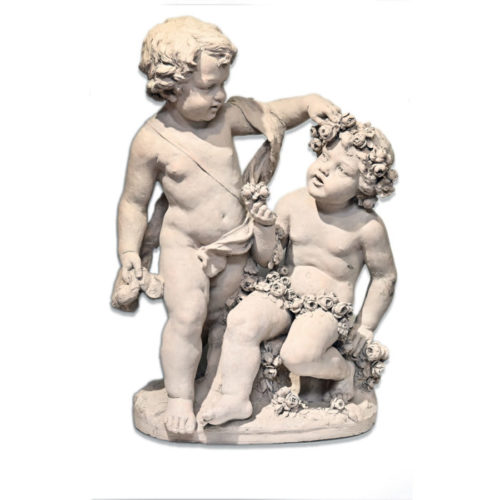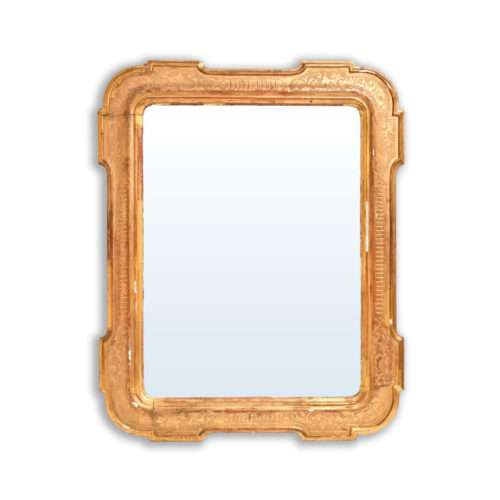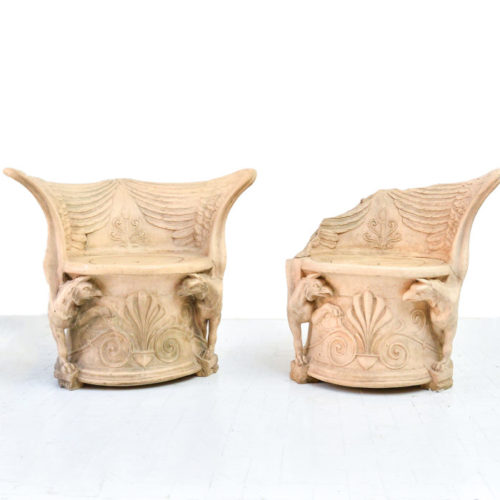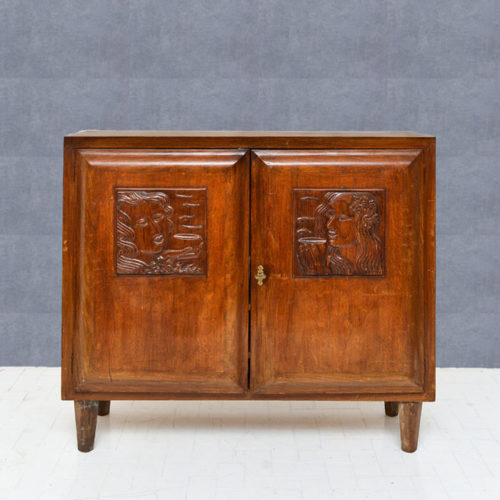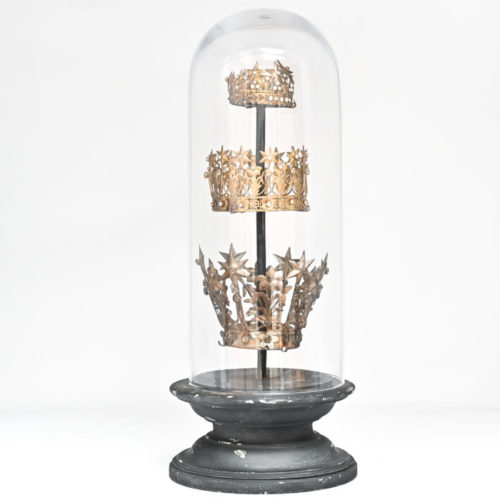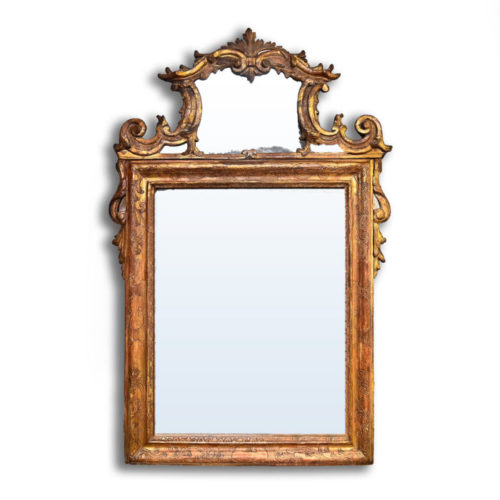Pair of Louis XVI style mirrors in carved and gilded lego with original glass.
-
Out of stock
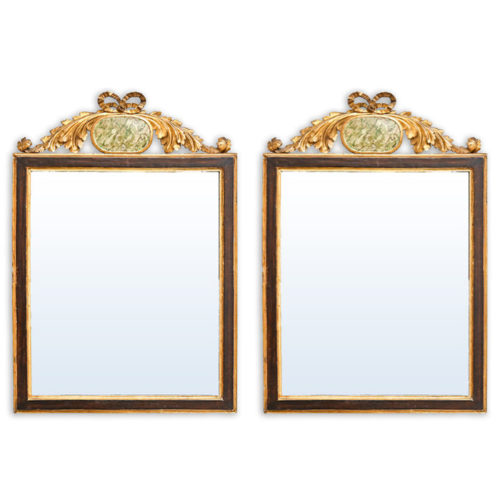 Period: End of the 18th century Measurements: H 72,5 x W 49,5 cm
Period: End of the 18th century Measurements: H 72,5 x W 49,5 cm -
Out of stock
 "Head of Satyr" - Bronze sculpture by Vincenzo Gemito (Naples, 16 July 1852 - Naples, 1 March 1929), Italian sculptor, designer and goldsmith. In Naples he was known as "’ o crazy sculptor " because he was tormented and marked by profound psychic imbalances; in reality his name was Vincenzo Gemito (Naples 1852 - 1929), a goldsmith and sculptor who, due to his condition, was often forced to take long breaks from his creative activity. His life was not simple right from the start: he was abandoned to his fate by his parents after being deposited in the wheel of exposures of the Annunziata plant. In fact, his real surname was Genito - "generated" - usually associated with orphans, but due to a mistake by a scribe the N became an M. Adopted and raised in a very poor family, from an early age Gemito proved to be gifted with immense talent for the plastic arts. His watchful eye loved to dwell above all on the scenes of the Neapolitan slums and his favorite subjects were children dressed in rags, commoners and players. The Gallerie d’Italia in Naples houses one of the most important nucleus of the artist's works, coming from the collection of the lawyer Gabriele Consolazio: terracotta, bronzes and drawings produced between the 1870s and the 1920s of the following century. The young heads modeled in terracotta - such as the impressive "Scugnizzo", "Fiociniere" and "Moretto" - testify to his tendency towards naturalism. Much more sophisticated are the bronze portraits of famous people, such as that of the Spanish painter Mariano Fortuny and his contemporary Domenico Morelli. His tireless plastic research is represented in particular by the "Philosopher's head" and the later "Neapolitan girl's bust", characterized by a sensual classicism that recalls the seductions and virtuosity of ancient Hellenistic sculpture. The drawings made with different materials and procedures are no less splendid: Gemito, in fact, knew how to master pencil, charcoal, ink, watercolor, sanguine and white tempera with the same skill. The engaging self-portraits are exhibited at Palazzo Zevallos Stigliano, merciless evidence of the painful changes in his physiognomy over the years; another important series on display consists of the figures of women where it is possible to observe the style research inspired by seventeenth-century models that made Vincenzo Gemito the last follower of Neapolitan naturalism.Period: '900 Measurements: H 42 x W 23 x D 23 cm
"Head of Satyr" - Bronze sculpture by Vincenzo Gemito (Naples, 16 July 1852 - Naples, 1 March 1929), Italian sculptor, designer and goldsmith. In Naples he was known as "’ o crazy sculptor " because he was tormented and marked by profound psychic imbalances; in reality his name was Vincenzo Gemito (Naples 1852 - 1929), a goldsmith and sculptor who, due to his condition, was often forced to take long breaks from his creative activity. His life was not simple right from the start: he was abandoned to his fate by his parents after being deposited in the wheel of exposures of the Annunziata plant. In fact, his real surname was Genito - "generated" - usually associated with orphans, but due to a mistake by a scribe the N became an M. Adopted and raised in a very poor family, from an early age Gemito proved to be gifted with immense talent for the plastic arts. His watchful eye loved to dwell above all on the scenes of the Neapolitan slums and his favorite subjects were children dressed in rags, commoners and players. The Gallerie d’Italia in Naples houses one of the most important nucleus of the artist's works, coming from the collection of the lawyer Gabriele Consolazio: terracotta, bronzes and drawings produced between the 1870s and the 1920s of the following century. The young heads modeled in terracotta - such as the impressive "Scugnizzo", "Fiociniere" and "Moretto" - testify to his tendency towards naturalism. Much more sophisticated are the bronze portraits of famous people, such as that of the Spanish painter Mariano Fortuny and his contemporary Domenico Morelli. His tireless plastic research is represented in particular by the "Philosopher's head" and the later "Neapolitan girl's bust", characterized by a sensual classicism that recalls the seductions and virtuosity of ancient Hellenistic sculpture. The drawings made with different materials and procedures are no less splendid: Gemito, in fact, knew how to master pencil, charcoal, ink, watercolor, sanguine and white tempera with the same skill. The engaging self-portraits are exhibited at Palazzo Zevallos Stigliano, merciless evidence of the painful changes in his physiognomy over the years; another important series on display consists of the figures of women where it is possible to observe the style research inspired by seventeenth-century models that made Vincenzo Gemito the last follower of Neapolitan naturalism.Period: '900 Measurements: H 42 x W 23 x D 23 cm -
Out of stock
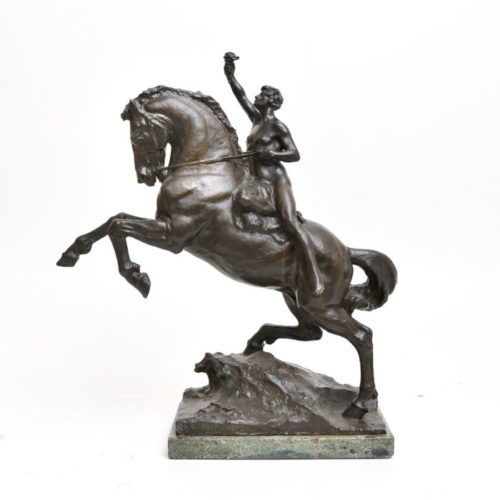 Bronze sculpture by Giacomo Buzzi Reschini (Viggiù, 4 September 1881 - Turin, 18 September 1962) dating back to the early 1900s. GIACOMO BUZZI RESCHINI The son of a marble craftsman, he went to Turin at a very young age to attend the Albertina Academy under the guidance of Luigi Belli first and then Leonardo Bistolf; however, he soon left school to open his own studio. In Turin he received awards and honors: in 1909 he made two medallions and presented the works "Non omnis moriar", "Vanaexpected", "Stella Alpina" (purchased by King Vittorio Emanuele III) at the Exhibition of Fine Arts, while in 1911 he received the gold medal for two equestrian groups. After the First World War, Buzzi Reschini resumed his activity by becoming friends with Canonica, Calandra, Bistolf, Pogliaghi and Enrico Butti, his fellow citizen. Buzzi Reschini was a brilliant artist: if his entire production is qualified by adhering to the romantic theme, liberty implications prevail in the works of the beginning of the century, while later he moved towards more sober and monumental forms, typical of the years of the "twentieth century". Of his vast production, we remember: "The Immaculate Conception" (1928), in travertine, with a height of 5 m, for the Palazzo del Governorato of the Vatican City; "Saints Cyril and Methodius" for the Bohemian College in Rome; "the War Memorial of Chieri" (1925), of Croce Mosso, of Bordighera, of San Damiano d’Asti (1927) and of Agliè; "the Four Prophets" (post 1930) for the facade of the church of the Annunciata in Turin, for which he also painted the Angels of the interior and the doors with Stories of the Virgin. "the Supreme Judgment" in the Monumental Cemetery of Milan, later destroyed in a bombing in 1943; "The last kiss" for the Monumental Cemetery of Vercelli; "The three Marys"," The Mass of the Dead"," Maternity"," S. Sebastiano"," La Pietà", "S. Francesco" for the Turin Cemetery; "The guards at the sepulcher" (1957). In the 1960s, next to the Butti Museum in Viggiù, he built a new pavilion with the intention of hosting his own plaster cast gallery and the plaster casts of other members of the Viggiutese sculpture of the twentieth century. His models are in fact set up in the central hall and in room II of the building.Period: Early 1900s Measurements: H 78 x W 69 x D 23 cm
Bronze sculpture by Giacomo Buzzi Reschini (Viggiù, 4 September 1881 - Turin, 18 September 1962) dating back to the early 1900s. GIACOMO BUZZI RESCHINI The son of a marble craftsman, he went to Turin at a very young age to attend the Albertina Academy under the guidance of Luigi Belli first and then Leonardo Bistolf; however, he soon left school to open his own studio. In Turin he received awards and honors: in 1909 he made two medallions and presented the works "Non omnis moriar", "Vanaexpected", "Stella Alpina" (purchased by King Vittorio Emanuele III) at the Exhibition of Fine Arts, while in 1911 he received the gold medal for two equestrian groups. After the First World War, Buzzi Reschini resumed his activity by becoming friends with Canonica, Calandra, Bistolf, Pogliaghi and Enrico Butti, his fellow citizen. Buzzi Reschini was a brilliant artist: if his entire production is qualified by adhering to the romantic theme, liberty implications prevail in the works of the beginning of the century, while later he moved towards more sober and monumental forms, typical of the years of the "twentieth century". Of his vast production, we remember: "The Immaculate Conception" (1928), in travertine, with a height of 5 m, for the Palazzo del Governorato of the Vatican City; "Saints Cyril and Methodius" for the Bohemian College in Rome; "the War Memorial of Chieri" (1925), of Croce Mosso, of Bordighera, of San Damiano d’Asti (1927) and of Agliè; "the Four Prophets" (post 1930) for the facade of the church of the Annunciata in Turin, for which he also painted the Angels of the interior and the doors with Stories of the Virgin. "the Supreme Judgment" in the Monumental Cemetery of Milan, later destroyed in a bombing in 1943; "The last kiss" for the Monumental Cemetery of Vercelli; "The three Marys"," The Mass of the Dead"," Maternity"," S. Sebastiano"," La Pietà", "S. Francesco" for the Turin Cemetery; "The guards at the sepulcher" (1957). In the 1960s, next to the Butti Museum in Viggiù, he built a new pavilion with the intention of hosting his own plaster cast gallery and the plaster casts of other members of the Viggiutese sculpture of the twentieth century. His models are in fact set up in the central hall and in room II of the building.Period: Early 1900s Measurements: H 78 x W 69 x D 23 cm -
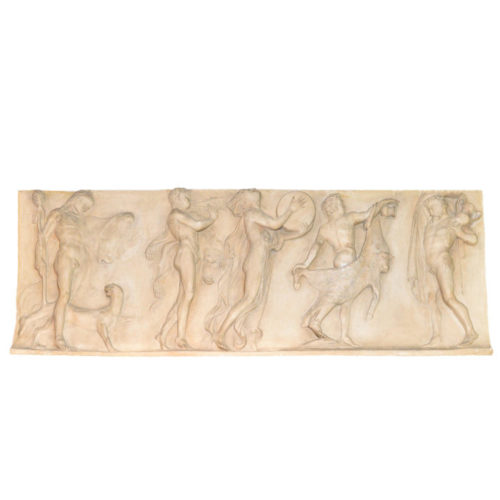 Period: Early 1900s Measurements: H 58 x W 157 x D 10 cmTerracotta panel depicting a classical scene. On the back the Manifattura di Signa brand. In excellent condition. The Manifattura di Signa is a historic terracotta pottery workshop. It was created in 1895 by the will of Camillo Bondi. "At the beginning of the twentieth century Signa was still one of the major industrial centers of straw. To that industry, which had made the name of the town known beyond national borders, was added another activity which, since the last five years of the nineteenth century and in a short space of years, it would have relaunched its name on the European and American markets: the artistic terracotta industry "Manifattura di Signa", founded in Signa (Florence), in 1895 by Camillo Bondi, on the premises of the factory " Fornaci di Signa "owned by his brother Angelo. At that time, the taste for antique fakes continued to seduce with all its charm, and in ceramics the interest in tradition had prompted the most important Italian manufacturers to revisit shapes and decorations Renaissance, reaching the ancient virtuosity of the historiated and grotesques with a high craftsmanship. If those productions interpreted the ancient with typical nineteenth-century eclecticism, the Manifattura di Signa on the other hand, it generated the perfect resemblance of the truth, both through the forms used when possible on the original, and by means of patinas simulating those of marbles and bronzes and even the faults of time, in order to obtain the appearance of the authentic piece, and visually as well as tactile and, in some bronzes, also sound. With this spirit, reproductions of sculptural and decorative masterpieces of all times will take shape from the Arno mud: from Etruscan to Greek statuary, from Roman to Renaissance, from Moorish vases to contemporary Art Nouveau creations. The success that ensued is witnessed by numerous exhibition awards such as the medal at the Universal Expo in Paris in 1900, where he exhibited numerous plastic terracotta, suitable for decorating the exteriors, with a particular patination that made it look better and more resistant to agents. atmospheric, soon expanded the number of occupations and the specialization of young artists assisted by the experience of sculptors of excellent fame, called to Signa for new ideas by the Bondi brothers, the brilliant founders and conductors of the Manufacture, coming from a family of Leghorn Jewish high bourgeoisie and close to the intellectual and anti-positivist environment of the Florentine magazine of “Il Marzocco”. With the new industry an informal school of young workers was thus generated in the Signe who, despite lacking regular education, growing under the experience of sculptors and in contact with the most sublime models of universal classicism, a real concentrate of museums in the world , were naturally stimulated and educated in the beauty and proportions of forms, so much so that they became refined craftsmen, plasticizers, sculptors, able to give life to other similar manufactories. " There are many artists who have collaborated with the Signa Manufacture: Oreste Calzolari, Giovanni Prini, Giulio Cantalamessa, Adolf von Hildebrand, Raffaello Romanelli, Giuseppe Santelli, Renato Bertelli, Giovan Battista Casanova, Bruno Catarzi, Italo Griselli
Period: Early 1900s Measurements: H 58 x W 157 x D 10 cmTerracotta panel depicting a classical scene. On the back the Manifattura di Signa brand. In excellent condition. The Manifattura di Signa is a historic terracotta pottery workshop. It was created in 1895 by the will of Camillo Bondi. "At the beginning of the twentieth century Signa was still one of the major industrial centers of straw. To that industry, which had made the name of the town known beyond national borders, was added another activity which, since the last five years of the nineteenth century and in a short space of years, it would have relaunched its name on the European and American markets: the artistic terracotta industry "Manifattura di Signa", founded in Signa (Florence), in 1895 by Camillo Bondi, on the premises of the factory " Fornaci di Signa "owned by his brother Angelo. At that time, the taste for antique fakes continued to seduce with all its charm, and in ceramics the interest in tradition had prompted the most important Italian manufacturers to revisit shapes and decorations Renaissance, reaching the ancient virtuosity of the historiated and grotesques with a high craftsmanship. If those productions interpreted the ancient with typical nineteenth-century eclecticism, the Manifattura di Signa on the other hand, it generated the perfect resemblance of the truth, both through the forms used when possible on the original, and by means of patinas simulating those of marbles and bronzes and even the faults of time, in order to obtain the appearance of the authentic piece, and visually as well as tactile and, in some bronzes, also sound. With this spirit, reproductions of sculptural and decorative masterpieces of all times will take shape from the Arno mud: from Etruscan to Greek statuary, from Roman to Renaissance, from Moorish vases to contemporary Art Nouveau creations. The success that ensued is witnessed by numerous exhibition awards such as the medal at the Universal Expo in Paris in 1900, where he exhibited numerous plastic terracotta, suitable for decorating the exteriors, with a particular patination that made it look better and more resistant to agents. atmospheric, soon expanded the number of occupations and the specialization of young artists assisted by the experience of sculptors of excellent fame, called to Signa for new ideas by the Bondi brothers, the brilliant founders and conductors of the Manufacture, coming from a family of Leghorn Jewish high bourgeoisie and close to the intellectual and anti-positivist environment of the Florentine magazine of “Il Marzocco”. With the new industry an informal school of young workers was thus generated in the Signe who, despite lacking regular education, growing under the experience of sculptors and in contact with the most sublime models of universal classicism, a real concentrate of museums in the world , were naturally stimulated and educated in the beauty and proportions of forms, so much so that they became refined craftsmen, plasticizers, sculptors, able to give life to other similar manufactories. " There are many artists who have collaborated with the Signa Manufacture: Oreste Calzolari, Giovanni Prini, Giulio Cantalamessa, Adolf von Hildebrand, Raffaello Romanelli, Giuseppe Santelli, Renato Bertelli, Giovan Battista Casanova, Bruno Catarzi, Italo Griselli -
Out of stock
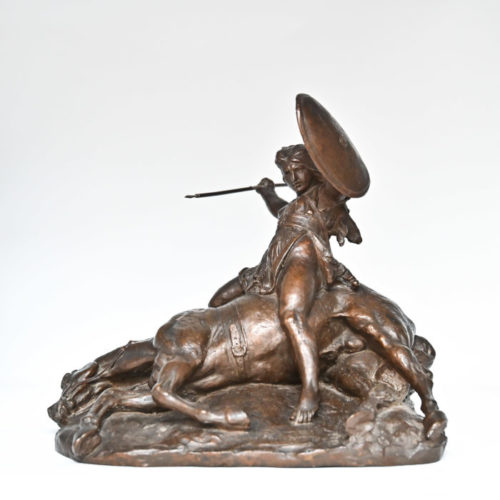 "The Amazon on horseback" - Bronze sculpture by Augusto Rivalta (Alessandria 1837 - Florence 1925) dating back to 1901. Signed and dated on the base. AUGUSTO RIVALTA (Alessandria, March 14, 1837 - Florence, April 14, 1925) was an Italian sculptor. After completing his studies at the Ligustica Academy, in 1859 he went to Florence for his specialization, attended the Duprè studio and the adherents to the Florentine current of the Macchiaioli. While settling in Florence, Rivalta maintains strong ties with Genoa. In this city, at the Staglieno Cemetery, there are many of his works and some of these are the Carlo Raggio Tomb, from 1872, the Drago Tomb from 1884, (for Giulio Cesare Drago, the donor of the railing of the Carignano bridge), the Pallavicino Tomb from 1892, the Ghigliani Tomb, etc. Since 1874 he has held the chair of Sculpture at the Florence Academy. A strong tendency towards a realistic approach is evident in his work. Among the many works by Rivalta that decorate Genoa, we must not forget the equestrian statue of Giuseppe Garibaldi, in Piazza De Ferrari, in front of the Carlo Felice theater and the Ligustica Academy. Especially in the plastic of the horse of this statue it is worth noting the realistic tendency and the technical skill of the modeling, characteristic of the Florentine school, which has dictates according to which the sculpture still passes through the laborious phase of the preparatory drawing. There are numerous commemorative statues of heroes of national unity. Rivalta performs, around the same time, two bronze statues for the Municipality of Sampierdarena, near the city of Genoa. Of these two statues, one in Piazza Monastero always depicts Giuseppe Garibaldi, this time standing. The other portrays the painter Nicolò Barabino, born in Sampierdarena, in the square of the same name. In the center of Genoa, in piazza Loading, the statue of Raffaele Rubattino is still his. Among his works is the bust of Christopher Columbus sent to Detroit (Michigan), from 1910. The subject of Christopher Columbus is also treated by one of his pupils, Francesco Caroni, who in 1892 painted the statue of Christopher Columbus seated and brooding, currently in courtyard of the Liceo Colombo in Genoa. The equestrian statue of Vittorio Emanuele II, originally placed in the Piazza Grande in Livorno and later moved in front of the nearby Government Palace, dates back to 1892. Another well-known work of Rivalta, a work completed at the end of his artistic career, are the sculptural groups of the Forza del Vittoriano in Rome: it is one of the four groups of Botticino marble statues on the pillars of the staircase, about 6 meters high. Around 1859 he volunteered to join the Carabinieri army, fighting for the liberation of Italy and later, returning to Florence, entered Giovanni Duprè's studio. Around 1861 he won the competition for the monument to Cavour in Turin which was not built because the artist was considered too young, thus entrusting the task to Duprè. Professor of the Academic College of Fine Arts in Florence since 1870, in 1883 he won the competition for the equestrian monument to Vittorio Emanuele II in Livorno; for the same city he created the monument to Garibaldi (1889). Author of the monument to Raffaele Rubattino (1889) and Garibaldi (from a sketch of 1889 and inaugurated on October 15, 1893) in Genoa, for the city of Chiavari he created those to Mazzini, Garibaldi (1890) and Vittorio Emanuele II, while in 1897 he executed in Florence the one in Bettino Ricasoli. Together with Antonio Garella in 1901 he created the monument to Rossetti in Trieste. The Garibaldi of Sampierdarena dates from 1905 and for the monument to Vittorio Emanuele II in Rome he painted the allegorical statue depicting The Force (circa 1910). Author of funerary monuments, portraits and genre works, at the Italian Exhibition of 1861 he exhibited Wounded Zouave, participated in the exhibitions of the Promoter of Fine Arts of Turin from 1863 and at the Florentine Spring in 1922 he presented the bronzes "The first death", "The holy family" and "Hercules" which overthrows the centaur, the latter already proposed in London in 1904. At the Turin Quadrennial in 1902 he presented "San Giovannino" and at the Venice Biennale in 1903 he exhibited "In Arcadia". In 1915 he exhibited "Satyr and Nimph" at the San Francisco International. In the National Gallery of Modern Art in Rome are preserved the works G. B. Niccolini, from 1864, oriented towards the realist taste of Adriano Cecioni, Spinning top player, repeatedly reproduced, "Child joking with the goat", "Return from the post office" and "Dancing Faun". The bronze "Antaeus" is preserved in the Galleria d'Arte Moderna in Milan, while in the Lima museum "Baccanale" (1904). Other works of his are also in the Gallery of Modern Art in Florence. His son Carlo (1887–1941), a sculptor, was his pupil.Period: 1901 Measurements: H 40 x W 44 x D 54 cm
"The Amazon on horseback" - Bronze sculpture by Augusto Rivalta (Alessandria 1837 - Florence 1925) dating back to 1901. Signed and dated on the base. AUGUSTO RIVALTA (Alessandria, March 14, 1837 - Florence, April 14, 1925) was an Italian sculptor. After completing his studies at the Ligustica Academy, in 1859 he went to Florence for his specialization, attended the Duprè studio and the adherents to the Florentine current of the Macchiaioli. While settling in Florence, Rivalta maintains strong ties with Genoa. In this city, at the Staglieno Cemetery, there are many of his works and some of these are the Carlo Raggio Tomb, from 1872, the Drago Tomb from 1884, (for Giulio Cesare Drago, the donor of the railing of the Carignano bridge), the Pallavicino Tomb from 1892, the Ghigliani Tomb, etc. Since 1874 he has held the chair of Sculpture at the Florence Academy. A strong tendency towards a realistic approach is evident in his work. Among the many works by Rivalta that decorate Genoa, we must not forget the equestrian statue of Giuseppe Garibaldi, in Piazza De Ferrari, in front of the Carlo Felice theater and the Ligustica Academy. Especially in the plastic of the horse of this statue it is worth noting the realistic tendency and the technical skill of the modeling, characteristic of the Florentine school, which has dictates according to which the sculpture still passes through the laborious phase of the preparatory drawing. There are numerous commemorative statues of heroes of national unity. Rivalta performs, around the same time, two bronze statues for the Municipality of Sampierdarena, near the city of Genoa. Of these two statues, one in Piazza Monastero always depicts Giuseppe Garibaldi, this time standing. The other portrays the painter Nicolò Barabino, born in Sampierdarena, in the square of the same name. In the center of Genoa, in piazza Loading, the statue of Raffaele Rubattino is still his. Among his works is the bust of Christopher Columbus sent to Detroit (Michigan), from 1910. The subject of Christopher Columbus is also treated by one of his pupils, Francesco Caroni, who in 1892 painted the statue of Christopher Columbus seated and brooding, currently in courtyard of the Liceo Colombo in Genoa. The equestrian statue of Vittorio Emanuele II, originally placed in the Piazza Grande in Livorno and later moved in front of the nearby Government Palace, dates back to 1892. Another well-known work of Rivalta, a work completed at the end of his artistic career, are the sculptural groups of the Forza del Vittoriano in Rome: it is one of the four groups of Botticino marble statues on the pillars of the staircase, about 6 meters high. Around 1859 he volunteered to join the Carabinieri army, fighting for the liberation of Italy and later, returning to Florence, entered Giovanni Duprè's studio. Around 1861 he won the competition for the monument to Cavour in Turin which was not built because the artist was considered too young, thus entrusting the task to Duprè. Professor of the Academic College of Fine Arts in Florence since 1870, in 1883 he won the competition for the equestrian monument to Vittorio Emanuele II in Livorno; for the same city he created the monument to Garibaldi (1889). Author of the monument to Raffaele Rubattino (1889) and Garibaldi (from a sketch of 1889 and inaugurated on October 15, 1893) in Genoa, for the city of Chiavari he created those to Mazzini, Garibaldi (1890) and Vittorio Emanuele II, while in 1897 he executed in Florence the one in Bettino Ricasoli. Together with Antonio Garella in 1901 he created the monument to Rossetti in Trieste. The Garibaldi of Sampierdarena dates from 1905 and for the monument to Vittorio Emanuele II in Rome he painted the allegorical statue depicting The Force (circa 1910). Author of funerary monuments, portraits and genre works, at the Italian Exhibition of 1861 he exhibited Wounded Zouave, participated in the exhibitions of the Promoter of Fine Arts of Turin from 1863 and at the Florentine Spring in 1922 he presented the bronzes "The first death", "The holy family" and "Hercules" which overthrows the centaur, the latter already proposed in London in 1904. At the Turin Quadrennial in 1902 he presented "San Giovannino" and at the Venice Biennale in 1903 he exhibited "In Arcadia". In 1915 he exhibited "Satyr and Nimph" at the San Francisco International. In the National Gallery of Modern Art in Rome are preserved the works G. B. Niccolini, from 1864, oriented towards the realist taste of Adriano Cecioni, Spinning top player, repeatedly reproduced, "Child joking with the goat", "Return from the post office" and "Dancing Faun". The bronze "Antaeus" is preserved in the Galleria d'Arte Moderna in Milan, while in the Lima museum "Baccanale" (1904). Other works of his are also in the Gallery of Modern Art in Florence. His son Carlo (1887–1941), a sculptor, was his pupil.Period: 1901 Measurements: H 40 x W 44 x D 54 cm -
Out of stock
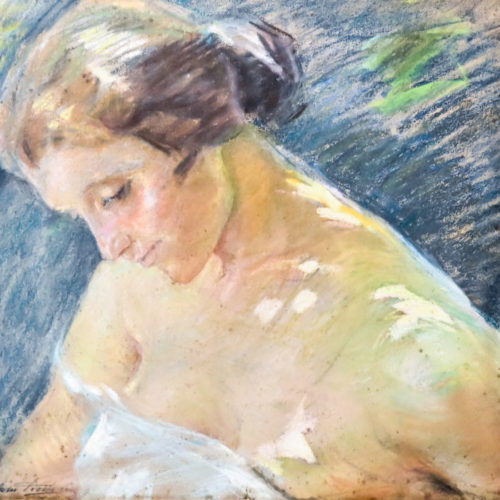 "Portrait of a woman" - Pastel on paper by Gino Piccioni dating back to the 1930s. Signed in the lower left corner. GINO PICCIONI Born in Fogligno on March 22, 1873, died in Biella in June 1941. He was taught by Achille Vertunni and Roesler Franz. He traveled abroad a lot and spent a long time in Germany. He devoted himself especially to landscape and portrait. Among his paintings are mentioned: Morning of Spring, in the Cologne Museum; Greeting of the beneficiaries, exhibited in 1901 at the Venice Biennale and sent to the Leningrad Art Exhibition, where he was awarded a silver medal Winter morning in the olive grove (1897), purchased by the Ministry of Agriculture; The Aniene near Tivoli, exhibited in 1899 at the Venice International; Quiete (1900), pastel purchased by King Umberto I; Cavalli alla "Trita", exhibited in 1927 at Palazzo Pitti. A pastel woman's head is in the Turri collection in Milan. After 1916 the artist had also devoted himself to sculpture, led by E. Ferrari.Period: 1930s Measurements: In frame H 70 x W 73 cm / Paper H 49 x W 54 cm
"Portrait of a woman" - Pastel on paper by Gino Piccioni dating back to the 1930s. Signed in the lower left corner. GINO PICCIONI Born in Fogligno on March 22, 1873, died in Biella in June 1941. He was taught by Achille Vertunni and Roesler Franz. He traveled abroad a lot and spent a long time in Germany. He devoted himself especially to landscape and portrait. Among his paintings are mentioned: Morning of Spring, in the Cologne Museum; Greeting of the beneficiaries, exhibited in 1901 at the Venice Biennale and sent to the Leningrad Art Exhibition, where he was awarded a silver medal Winter morning in the olive grove (1897), purchased by the Ministry of Agriculture; The Aniene near Tivoli, exhibited in 1899 at the Venice International; Quiete (1900), pastel purchased by King Umberto I; Cavalli alla "Trita", exhibited in 1927 at Palazzo Pitti. A pastel woman's head is in the Turri collection in Milan. After 1916 the artist had also devoted himself to sculpture, led by E. Ferrari.Period: 1930s Measurements: In frame H 70 x W 73 cm / Paper H 49 x W 54 cm
